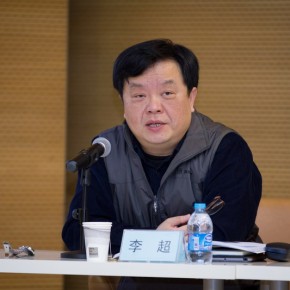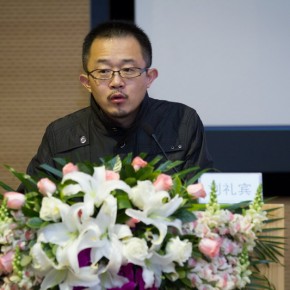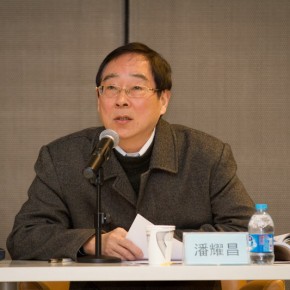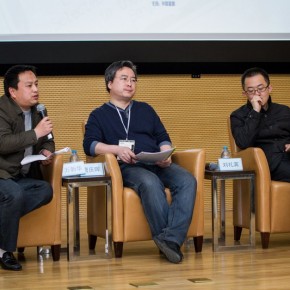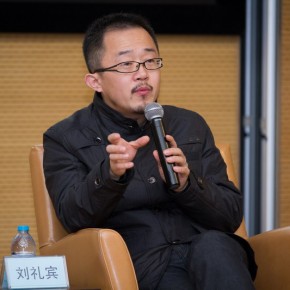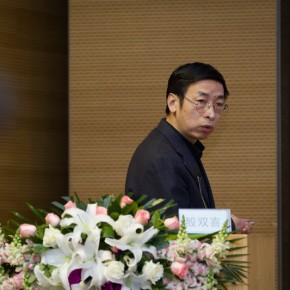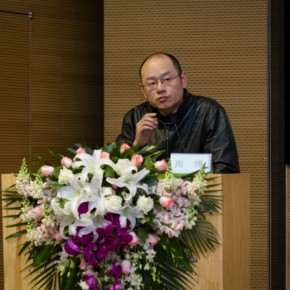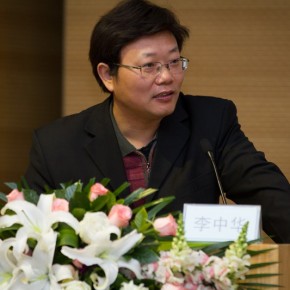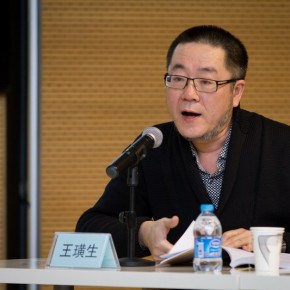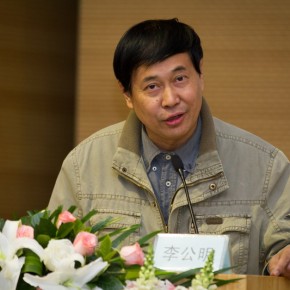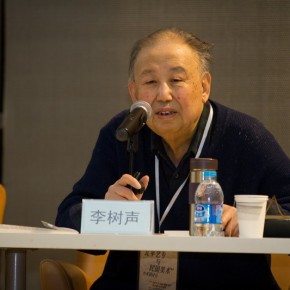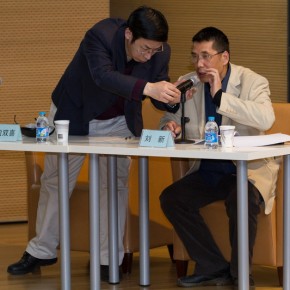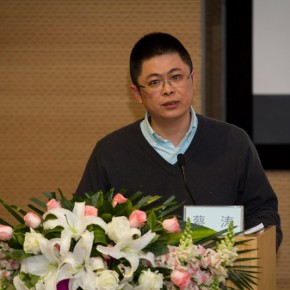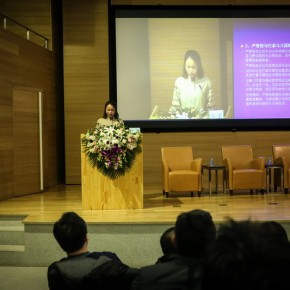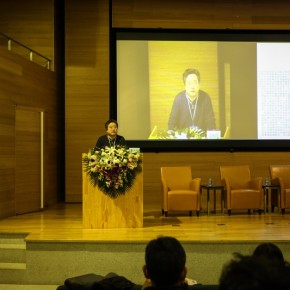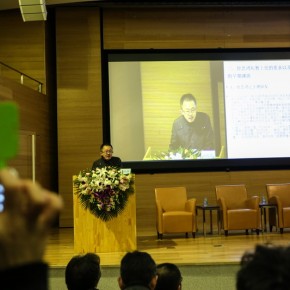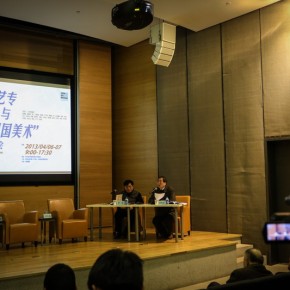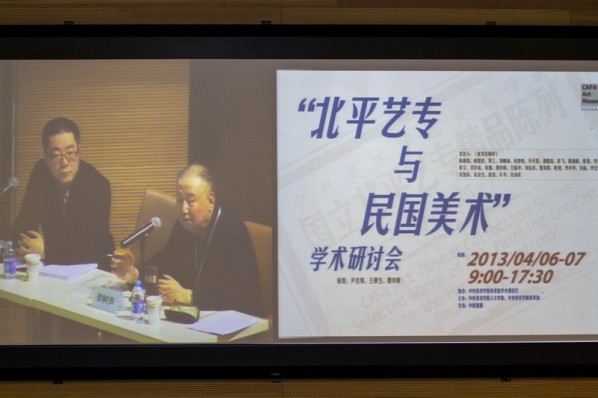
The fifth section: keyword “Art Education”
At 8:50 am, on April 7, the representative of Zhang Peng, Deputy Editor in Chief, and researcher of “Art Studies”, read her paper on “Yan Xiu and His Son and Modern Chinese Art Education”. Yan Xiu was a famous modern educator, scholar, and a pioneer that changed feudal education, advocating modern education. Zhang Peng had a detailed combing through and research of the activities of Yan’s, for example “enlighten the people and popularize art education”, “visit, propose and implementation of various museums and galleries in Tianjin”, Pan Yaochang said the study of the Yan’s family was of benefit for combing through the modern history of the National Beiping Art School, and filled with the awareness of problems, Yan can be recognized as an elite member of society of the time, we could find the thinking and consensus of the upper classes, recognizing modern art education,during the period of the Republic of China.
Then, Cao Qinghui, Deputy Director of the School of Humanity, CAFA, gave a speech themed “Preliminary Study of the Evolution of the Beijing Education System of Chinese Painting Study in the Period of the Republic of China”, which started from Xu Beihong carrying out the reform of the Chinese painting education, talking about the concept of progress to the value of Chinese painting: “Education of Chinese Painting”, as well as the theory of the decline and the improvements in Chinese Painting: “Realism”, etc. Pan Yaochang thought, “The System of Chinese Painting Study” was an important concept, Chinese painting had been reformed with the impact of Western realism and a selection of Chinese tradition, and the so-called Chinese paintings today are of Chinese character.
Wan Xinhua, an associate researcher from the Art Institute of the Nanjing Museum, gave a speech themed “About the Teaching of Chinese Painting of the Department of Arts of the Normal College, National Central University, he thought Xu Beihong’s status and role were deified by the people, and the interpretations of some historical events were distorted, which should be rectified, the intention of combing through the teaching activities of the Chinese painting was to restore the truth. Pan Yaochang agreed with his view and believed that there were many people contributing to the Nanjing Art Education of the period of the Republic of China, besides Xu Beihong. At the same time, Xu’s ideology and theory and the related practice had changed at different times.
Finally, Liu Libin, lecturer of the Institute of Fine Arts Study, CAFA, gave a speech themed “National Beiping Art School: the Development of Sculpture in the Period of the Republic of China – Appearing Events and the In-depth Meanings”, topics including the position of sculpture in Cai Yuanpei’s mind, Cai and Xu paying attention to sculptures, such as Hua Tianyou and Wang Linyi. Pan Yaochang appreciated Liu’s detailed collections.
The sixth section: keyword “Pattern of Teaching”
Yin Shuangxi, the executive editor and researcher of “Art Research”, CAFA, initially gave a speech “The Practical and Aesthetic – the Discipline of Pattern of the National Beiping Art School”, talking about the Westernized transformation of art Education and the application of mainstream art of the late Qing Dynasty. Yin Shuangxi emphasized the educational acts performed by Yan Zhikai (1894-1942), President of the National Beiping Art School, Tokyo Art School, and the early Chinese art education.
Subsequently, Zhou Bo, lecturer of the School of Design, CAFA, gave a lecture themed “Beijing Art School and the Beginning of Modern Chinese Design Education – Studying the Knowledge Around ‘Handouts of the Principles of Pattern’ of the Beijing Art School”.
Chou personally collected seven Handouts of the Principles of Pattern in the period of the Beijing College of Arts”, combing through and studying the relationships between Beijing Art School and the original modern Chinese design education in the perspectives of the transmission of knowledge and ideology.
Prof. Li Zhonghua, Vice President of the College of Art and Design, Hubei Engineering University, gave a speech: “Beijing mode” of the early Republic of China: Study of the Education of Pattern, combing through the development evolution of the design education “pattern – craft art – art design”, from the 20th century.
The seventh section: keyword “Oil Painting and Chinese Painting”
Prof. Li Gongming, from the Department of Art History, Guangzhou Academy of Fine Arts, initially gave a lecture entitled “Xu Beihong’s Realism and the Transformation of Chinese Painting”, with the research topics: the relationships and differences between Xu Beihong’s realism art thinking and practice and the transformation movement of the Chinese painting since 1949; the evaluation of this phenomenon from the perspective of “the tradition of socialist art”.
Prof. Liu Xin, from Guangxi Arts Institute gave a lecture of “From the National to the Central – Rediscovery of the Northern Route and the Central Pattern for the Evolution of the Early Western Painting in China”, revealing the dominant status of the National Beiping Art School, for its location, and superior cultural environments.
Wu Xueshan, associate professor of the Minzu University of China, gave a speech: “New Chinese Painting” – Xu Beihong and the Appearance of the Emerging Writers”. Wu pointed out that Xu Beihong’s concept of “New Chinese Painting” “focused on forms and techniques, rarely the reform of the content”, which finally inevitably failed. However, the “emerging writers” left at the Beiping Art School, and the CAFA serve as the foundation of the Chinese Figure Painting.
Finally, Zhu Jingshen, an associate researcher at the National Academy of Arts, gave a speech themed: the Battle of the Ways – the Event of the Strike between Three Professor including Qin Zhongwen, Li Zhichao, and Chen Yuandu, with President Xu Beihong, and the Related Debate of Chinese Painting, which began on October 2, 1947.
Li Shusheng summarized the four speeches, and said that the mission of the students was very clear, it is to save the nation.
The eighth section: keyword “Collections and Design”
Cai Tao, associate researcher at the Institute of Art Study, Guangzhou Academy of Fine Arts initially gave a lecture entitled “The Battle of Art Propaganda between China and Japan in the early period of the Sino-Japan War – Talking from the ‘Sketch of Wuhan Mural Painting’ of Wang Shiguo in the collection of the CAFA Art Museum”,
Professor Xu Ping, Director of the Department of Graduate, CAFA, gave a speech on “A Group of Historical Images Which Couldn’t be Forgotten - People and Events of Graphic Design to the Early Revolution Activities of CPC.”
Finally, Ms. An Yongxin, deputy director of the Library of CAFA, gave a lecture entitled “It Will Not Go Well in the War, While the Great Artist Has Wonderful Works - Yazaki Chiyoda’s Artistic Career”, Yazaki Chiyoda was one of two Japanese teachers in CAFA’s history, and more than one thousand of his paintings are collected by CAFA Art Museum, An Yongxin believes that he was worthy of research.
Closing Ceremony
Yin Jinan and Wang Huangsheng gave a speech at the ceremony, presided over by Cao Qinghui, at 17:30, on April 7.
The end.
Photography: Hu Zhiheng/CAFA ART INFO
Journalists: Sun Tianyi, Yu Ya/CAFA ART INFO
Translated by Chen Peihua, edited by Sue/CAFA ART INFO



